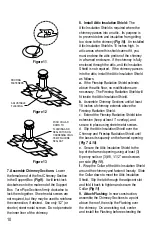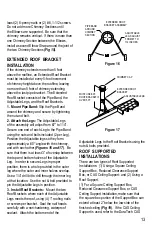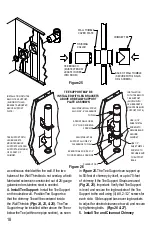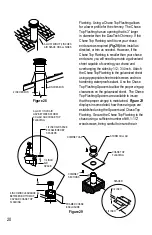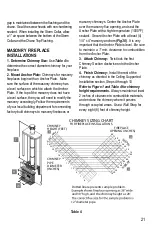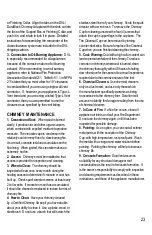
23
or Finishing Collar. Align the tabs on the DVL/
DuraBlack Chimney Adapter with the slots cut into
the face of the Support Box or Finishing Collar, and
push it in, and rotate to lock it in place. Detailed
instructions for assembling the remainder of the
close clearance system are included in the DVL
shipping cartons.
3. Connection to Oil-Burning Appliance:
DVL
is especially recommended for oil appliances
because of the corrosive nature of oil-burning
exhaust. When connecting to an oil burning
appliance, refer to National Fire Protection
Association Standard #211. Table 6-5.1.1 in NFPA
211 states that you must allow for 18” clearance
to combustibles if you are using single wall vent
connector. If , however, your appliance is Type-L
Vent listed and you are using a listed Type-L Vent
connector, then you are permitted to use the
clearances as specified by the vent listing.
CHIMNEY MAINTENANCE
1. Creosote and Soot:
When wood is burned
slowly, it produces tar and other organic vapors,
which combine with expelled moisture to produce
creosote. The creosote vapors condense in the
relatively cool chimney flue of a slow-burning fire.
As a result, creosote residue accumulates on the
flue lining. When ignited, this creosote makes an
extremely hot fire.
2. Access:
Chimneys must be installed so that
access is provided for inspection and cleaning.
3. When to Clean:
The chimney should be
inspected at least once every month during the
heating season to determine if creosote or soot has
built up. Check spark arrestor screens at least every
2 to 4 weeks. If creosote or soot has accumulated,
it should be cleaned or replaced to reduce the risk of
chimney fire.
4. How to Clean:
Have your chimney cleaned
by a Certified Chimney Sweep if you have doubts
about your ability to clean it. Use a plastic, wood, or
steel brush. Do not use a brush that will scratch the
stainless steel liner of your chimney. Scrub the spark
arrestor with a wire brush. To remove the Chimney
Cap for cleaning unscrew the four (4) screws that
attach the cap’s support legs to the cap base. The
Tee Cleanout Cap can be removed by turning
counter-clockwise. Be sure to replace Tee Cleanout
Cap when you are finished cleaning the chimney.
5. Coal:
Warning:
Coal with a high sulfur content can
lead to premature failure of the chimney. To reduce
corrosion in chimneys where coal is burned, clean
the chimney thoroughly within 48 hours of shutting
down the stove for the season. An annual inspection is
required due to the corrosive nature of the fuel.
6. Chemical Cleaners:
Use chemical cleaners
only as a last resort, and use only those which
the manufacturer specifically warrants as being
noncorrosive to the chimney liner. DuraVent will
assume no liability for damage resulting from the use
of chemical cleaners.
7. In Case of Fire:
If a flue fire occurs, close all
appliance air inlets, and call your Fire Department.
Do not use the chimney again, until it has been
inspected for possible damage.
8. Painting:
As an option, you can coat all exterior
metal parts, with the exception of the Chimney
Cap, with high temperature, rust proof paint. Wash
the metal with a vinegar and water solution before
painting. Painting the chimney will help to increase
chimney life.
9. Creosote Formation:
DuraVent assumes
no liability for any structural damage or roof
contamination as the result of creosote formation. It
is the owner’s responsibility to comply with inspection
and cleaning requirements as described in these
instructions, and those of the appliance manufacturer.


